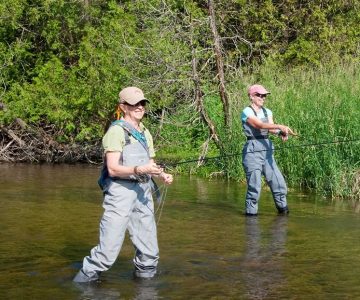Conservation Authorities v. Doug Ford
The provincial government is stripping Ontario’s conservation authorities of the very meaning of their name – and key protections for the environment.
“Since the 1940s, our province has greened so remarkably, but also so imperceptibly that we have lost sight of the achievements of our conservation authorities,” says John Riley, science advisor emeritus for the Nature Conservancy of Canada and a Mono resident. “While not perfect, they are a commendable institutional legacy, and the act under which they operate is an environmental Magna Carta of sorts. It awards much-needed rights to our natural world. To improve our conservation authorities is laudable, and we weaken them at our peril.”
Like a mounting number of Ontarians, Riley is appalled at changes Doug Ford’s Progressive Conservative government imposed on conservation authorities last December with the passage of its omnibus budget Bill 229. Buried in Schedule 6 of the Protect, Support and Recover from Covid-19 Act were amendments to the Conservation Authorities Act that put economic interests in the driver’s seat, relegating environmental considerations to the back of the bus.
In combination with the government’s escalating use of ministerial zoning orders, the changes allow developers to circumvent local planning processes and development controls, deprive CAs and citizens the right to appeal development approvals, and deny CAs the right to turn down projects even if they pose a threat to the environment and people. The Ontario government says the measures are all aimed at reducing red tape as a way of creating jobs and restarting the pandemic-ravaged economy.
Reaction to the government’s move was swift, widespread and overwhelmingly negative.
“I’ve been in this business for over 40 years,” says Deborah Martin-Downs, chief administrative officer of Credit Valley Conservation, “and I’ve never seen anything like the outpouring of support for conservation authorities and the work we do for the environment.” Although she is only an occasional social media user, Martin-Downs says when she posted her resignation on LinkedIn, it received 53,000 views.

Osprey on nest. Photo by Robert McCaw.

Credit River at Belfountain. Photo by Rosemary Hasner / Black Dog Creative Arts.
Among the many organizations who formally declared their dissent were the Ontario Federation of Agriculture, the Canadian Environmental Law Association, Ontario Nature, the World Wildlife Fund, Environmental Defence and the Association of Municipalities of Ontario. Locally, the towns of Mono, Orangeville and Shelburne, as well as the Region of Peel, were among the more than 40 municipal councils across Ontario that petitioned the government to repeal Schedule 6.
Last December 5, half the board of the Greenbelt Council – the government’s own appointed advisory body – resigned in protest. On December 8, the government brazened out the opposition and passed its budget bill with Schedule 6 largely intact.
In his letter of resignation, Greenbelt Council chair and former Toronto mayor David Crombie didn’t mince words. Schedule 6, he wrote, “cuts out the heart of integrated watershed planning and management; severely cripples the Conservation Authorities in the pursuit of their historic stewardship of environmental issues, and now with the grossly expanded use of ministerial zoning orders and other procedural revisions, essential public discussion and debate will be stifled or shut down. This is not policy and institutional reform. This is high-level bombing and needs to be resisted.”
A disillusioned Martin-Downs also resigned from the council: “I believed that being ‘in the tent’ was valuable and that I could contribute to good public policy that makes Ontario great. However, it is now clear that the government’s direction … is a blatant assault on conservation, the environment and transparent governance.”
A watershed-wide approach
The Headwaters region derives its name from the four rivers that begin their journeys here to either Lake Ontario, Lake Erie or Georgian Bay. Taking care of these waterways, their tributaries, floodplains and riparian habitat are four CAs: Credit Valley Conservation, the Grand River Conservation Authority, the Nottawasaga Valley Conservation Authority and the Toronto and Region Conservation Authority which safeguards the Humber River as well as other watersheds in the GTA.
Many of us are most familiar with CAs because of their recreational amenities – the hiking trails, fishing, canoeing and sugaring off events offered in conservation areas such as Terra Cotta, Island Lake, Glen Haffy and Albion Hills among others. Over the past year, conservation areas were newly discovered by thousands of pandemic-weary urbanites seeking relief in nature. (In 2020, for example, NVCA reported a 60 per cent increase in visits to its 11 conservation areas).

A beaver dam. Photo by Robert McCaw.

Grey tree frog. Photo by Rosemary Hasner / Black Dog Creative Arts.
But the primary and more critical mandates of the CAs encompass source water protection, flooding and erosion mitigation, and the health of fish and wildlife. In particular, CAs play a key role in evaluating development applications by providing municipalities with the science-based technical information they require.
CAs came into being after the Ontario government passed the Conservation Authorities Act in 1946 in response to growing concern about the impact of a burgeoning population on nature. They were conceived as a way to combine conservation with efforts to find work for World War II veterans. Although this latter feature was never realized, the movement grew – first into community-driven, watershed-based entities and then, in the fallout from the disastrous flooding caused by Hurricane Hazel in 1954, as organizations focused on flood and erosion control, pollution abatement and recreation. Since 2002, after the Walkerton tragedy, CAs also have responsibility for implementing the Clean Water Act.
Conservation Ontario, the organization that gives the province’s 36 CAs a unified voice, describes these uniquely Ontario entities as agencies that “deliver services and programs to protect and manage impacts on water and other natural resources in partnership with all levels of government, landowners and many other organizations.” Significantly, CAs strive to balance “human, environmental and economic needs.” In other words, as Riley points out, they give the natural world a seat at the negotiating table.
Collectively, CAs own and protect 150,000 hectares of land in Ontario, second only to the Crown. Reasoning that owning land is the best way to protect it, TRCA, in particular, has an aggressive plan to secure more land within its watersheds. Currently TRCA owns more than 18,000 hectares, more than 7 per cent of the watersheds it manages.
What makes Ontario’s CAs the envy of conservationists the world over is that they operate on a watershed-wide basis, rather than the more common piecemeal approach dictated by arbitrary municipal boundaries. Because the whole-watershed approach is so eminently sensible and has been around for nearly 75 years, it might seem unremarkable to us. How would it be possible to manage flooding, water quality or flow if each jurisdiction operated its part of the watershed in isolation from the rest?
Despite this common-sense approach, town of Erin mayor Allan Alls is not alone in complaining that CAs’ mandatory environmental reviews of development projects can be cumbersome and slow, holding up approvals. He grumbles about the $75,000 in annual levies the town must pay to the two CAs within its boundaries. But Alls is also quick to add, “They save towns a lot of money.” He recognizes that Erin has neither the expertise nor the staff to undertake the essential technical and scientific work CAs do on behalf of municipalities.
Although the province calls the shots for CAs, it contributes as little as 1 or 2 per cent to their operating costs. Municipalities contribute more than 50 per cent and the rest is raised through park admissions and landowner services, corporate and community sponsorships and a small portion from federal grants. CAs operate under the direction of a municipally appointed board and 70 per cent of board members must be municipal councillors who have to balance the sometimes conflicting pressures of their dual responsibilities.

Brook trout in a Caledon stream. Photo by Don Scallen.

Fly fishing on the Pine River. Photo by Rosemary Hasner / Black Dog Creative Arts.
In its resolution asking the Ford government to repeal Schedule 6, the Town of Mono noted, “In 2021 Mono will spend $133,365 on conservation authorities. If we had to hire our own employees – engineers, planners, ecologists, hydrogeologists, foresters, outdoor educational staff, etc. – to do our own work, we would spend much more than $133,365 for these services.” Clearly upset with the Ford government’s assault on CAs, Mono mayor Laura Ryan and her council added, “And we were particularly unimpressed when your government slipped these proposed changes to the Conservation Authorities Act into a budget bill.”
What is the Ford government up to?
As Mono council pointed out, the Ford government buried Schedule 6 among 44 other schedules attached to Bill 229. This move follows on the heels of the government’s 50 per cent cut to CAs’ flood control budgets (even as local communities like Grand Valley and Bolton are experiencing more floods), its elimination of the office of the environmental commissioner, cancellation of tree-planting initiatives, its resurrection of Highway 413, and its bewildering population growth targets for the Greater Golden Horseshoe.
This provincial push for suburban growth puts more and more stress on watersheds as a result of water taking, sewage dumping, land clearing, and pollution from increased car- and truck-based transportation. According to Conservation Ontario, 95 per cent of Ontarians live within a watershed managed by a CA – mostly in the Greater Golden Horseshoe.
Erin’s population, for example, is slated to more than triple to 14,000 from 4,200 over the next 20 to 30 years, but that’s not the worst of it. According to TRCA board chair and Caledon councillor Jennifer Innis, under new population targets set out in the 2020 Provincial Policy Statement, Caledon now has “the highest trajectory of growth in the GTA.” Brampton will burst its seams, overwhelming Caledon’s agriculturally rich Peel Plain as the town explodes from a population of 80,000 today to more than 300,000 by 2051.
It all indicates a provincial government determined to shed the anti-sprawl approach to growth in the Greater Golden Horseshoe that has dictated planning for the past two decades or more. And that puts extraordinary provincial, municipal and corporate pressure on CAs to yield to development despite its cumulative impact not only on our water resources but also on both the anticipated and the unknown consequences of a warming climate.

Blue-stain fungus. Photo courtesy CVC.

Fluffy cygnets. Photo courtesy CVC.
Tim Gray, executive director of the Toronto-based non-governmental organization Environmental Defence, says of the government’s pro-development agenda, “It’s an ideological aversion to urban life. They want sprawl.” Martin-Downs is more direct: “It’s all pandering to the development community.”
Environmental Defence has partnered with more than a dozen other environmental organizations to launch a wide-ranging campaign called Yours to Protect. On its website, the group states, “We came together to say that we live here, we love this province and we are not going to let it be dug up, paved over and polluted.”
What is the role of CAs?
To understand the role CAs play in the development approval process, consider the town of Erin’s plans for a wastewater treatment plant, aka sewage plant. Before receiving approval, the project must go through an environmental assessment, which involves review and comment from various organizations, including Credit Valley Conservation.
If built, this controversial project will cost each household in the villages of Erin and Hillsburgh at least $17,000. It will allow Solmar Development Corp. and others to build ever-expanding rings of suburban housing around the two villages where growth has so far been limited by a lack of sewage capacity. But these are not the direct concerns of the CVC.
The proposed plant is also slated to dump 7.2 million litres of wastewater a day into the West Credit River just upstream from the hamlet of Belfountain and near some of southern Ontario’s most pristine brook trout spawning beds. Brook trout require cold water to survive and would be threatened by an influx of warm effluent.

The marsh boardwalk at Terra Cotta Conservation Area. Photo courtesy CVC.

Red-spotted newt. Photo courtesy CVC.
Despite what many think, CVC doesn’t “approve” a project like this. That responsibility goes to the Ministry of the Environment, Conservation and Parks which approves the environmental assessment and is also responsible for reviewing and approving the plant and its discharge, including the effluent temperature. CVC is responsible only for the portion of the project located on a natural hazard, such as a wetland or floodplain, expected in Erin’s case to be the pipe that will carry the effluent from the plant to the river. CVC will review the detailed design submission and determine requirements for permits prior to construction.
The MZO override
One of the tools the Ford government is increasingly relying on in its pursuit of “streamlining” development approvals is the ministerial zoning order which enables the minister of municipal affairs and housing to override the local planning process. Although MZOs have long been included in Ontario’s Planning Act, their intended use was for emergencies, not political expediency. An MZO was issued, for example, to quickly permit construction of a new grocery store in Elliot Lake after the town’s only supermarket collapsed in 2012.
Between 2000 and 2018, previous provincial governments had used MZOs about once a year. The Ford government has now applied this mechanism more than 40 times. A map on the Yours to Protect website details each MZO currently approved or under consideration.
Schedule 6 further consolidated the power of the MZO by forcing CAs to issue a permit on otherwise protected land. Moreover, by using an MZO, the government denies the right of CAs and citizens to appeal a project even if it goes against the CA’s scientific assessment and its provincially mandated responsibility to protect people, infrastructure and the environment.
On the other hand, Schedule 6 has expanded the appeal process for developers or municipalities by allowing them to leapfrog the CA and go to either the Local Planning Appeal Tribunal or directly to the minister of natural resources and forestry who can approve a project without input from a CA. In either case, a CA would not have standing to present its case, except in the unlikely scenario the minister or proponent requests it.
Doug Hevenor, chief administrative officer of NVCA, says, “These amendments go beyond simple changes. They remove science from the equation by politicizing these decisions, effectively eliminating the local knowledge of the conservation authorities to accurately forecast the risk to the environment, infrastructure and human life.”
Hevenor adds, “I think that if you look you can see that some developers have supported our government. So, [Schedule 6] is a chance for government to shorten the process for them.” But if shortening the process is the government’s goal, the expanded opportunity for developers to appeal may be counterproductive. The appeals tribunal, even without this added role, is already under duress with a current backlog of more than 1,000 cases. As a result, opponents say the new legislation could slow down, not speed up the approvals process – thereby adding more, not less of the dreaded red tape. Conservation Ontario predicts the changes could delay approvals by as much as 200 days.
An MZO can also be requested and granted without public notice, as happened in Caledon last summer. Normally Peel Region is required to approve an official plan amendment for a new development. In this case, town council was frustrated that Peel had twice deferred the town’s longstanding plans for a low-density, car-dependent development of 7,500 residences on prime agricultural land in southwest Caledon. Peel cited concerns about the costly infrastructure needed to support a greenfield development they weren’t sure was needed given population growth throughout the GTA has not kept pace with the province’s projections. The Caledon motion to request an MZO was introduced and passed mid-council meeting without prior notice to the public or the region who, once the MZO was issued, had no avenue for appeal.
Beyond the obvious risks to people and the environment of the new direction, Samantha Lawson, CAO of Grand River Conservation Authority, ponders its ethical and legal ramifications. Who is liable, she wonders, if a CA is forced to issue a permit for a project that its scientific investigations indicate is hazardous? The TRCA went a step further. It forwarded a motion asking the government for a liability clause – one that would make the government accept legal responsibility in the event that disaster strikes. Jennifer Innis also raised a question for a government seemingly intent on relegating science to a back seat. With regard to due diligence, she asked, “What science are you using to trump the CA’s science?” Despite this logic, TRCA’s motion was not approved.

White-tailed deer. Photo courtesy CVC.

A beaver dam. Photo by Robert McCaw.
The poster child for the Ford government’s use of MZOs is the one issued to the Triple Group of Companies to greenlight a 4-million-square-foot Amazon distribution centre in Pickering next the developer’s massive hotel and entertainment complex called Durham Live. The proposed warehouse is on Lower Duffins Creek, a “provincially significant wetland” that provides floodwater containment, is a breeding ground for fish and amphibians, and an important stopover for migratory birds.
Perhaps as disturbing, the MZO was issued even though the neighbouring town of Ajax was vying for the same project just a kilometre away on land that is not environmentally fragile and where presumably – given that employment is the Ford government’s stated goal – the same number of jobs would be created.
As part of the MZO, TRCA was directed to sign what critics call a “pay to slay” agreement with the developer. Such an agreement, contained in another provision of Bill 229, allows for a kind of ecosystem swap in which a developer pays to replace lost wetland. Innis says that despite the TRCA’s efforts, it has been unable to find a replacement property in the watershed. And if it could, she says, the Triple Group of Companies would have to cough up an estimated $40- to $60-million to purchase it.
Following months of controversy and a CBC News investigation, Amazon announced in mid-March it will seek an alternative site for its warehouse. Amazon’s withdrawal does not mean the land will not be built on, but municipal affairs minister Steve Clark has asked Pickering if it wants to amend the MZO to remove the wetland from development plans.
The Duffins Creek MZO prompted Environmental Defence to team up with Ontario Nature and law firm Ecojustice to take the provincial government to court. They argue the provincial government is breaking the law by superseding its own Provincial Policy Statement in permitting development on the wetland. However, the government moved quickly to short circuit the legal challenge. Hidden within Bill 257, Supporting Broadband and Infrastructure Expansion, introduced in early March, is an amendment to the PPS that makes MZOs retroactively exempt from its provisions, except within the Greenbelt.
We weaken CAs at our peril
CAs are not without their critics, and the Ford government may well have been surprised by the ferocity of the backlash against Schedule 6. Even outside of the commercial development industry, many a private landowner has been frustrated by what often seem like unnecessarily petty restrictions on minor renovations or secondary outbuildings. “Nobody likes to be regulated or told no,” Martin-Downs acknowledges. “There are times we haven’t said no in the best way… These things haven’t stood us well over time.” She continues, “We’ll never be perfect, but we are trying.”
Innis believes that rather than gutting CAs, it would be better to improve the planning process. She would like the various agencies involved in development applications to get together and come up with a more streamlined approach to avoid duplications and inconsistencies.
Conversely, on larger projects, CAs have been accused of caving to political pressure – and the new amendments to the Conservation Authorities Act will now make it even harder for them to hold the line. In his support of Erin’s proposed sewage plant, for example, Mayor Alls repeats the mantra endorsed by many a municipal politician: “[If] you don’t grow you die.”
Still, for much of living memory, CAs have been minding our watersheds in a technical, science-based way, and it appears that whatever their faults, loyalty to their essential value resides deeply within the Ontario psyche. Although Schedule 6 passed, the resulting hue and cry may have caused the Ford government to adjust its course, at least in part. NVCA’s Hevenor says, “The public voice was loud enough on this that some folks are worried about getting re-elected.”
According to Martin-Downs, public outrage seemed to have dissuaded Queen’s Park from its original plan of releasing the regulations that will drive Schedule 6 back in December without consultation.
Instead, the government announced the formation of the Conservation Authority Working Group. Chaired by Hassaan Basit, president and CEO of Conservation Halton, the group is made up of representatives from CAs, Conservation Ontario, municipalities, and the development and agricultural sectors (arguably the kind of mix that should make up a CA’s board of directors). The group’s mandate is to determine how the regulations will guide implementation of the broad framework and direction set out in Schedule 6.
Their deliberations will have a profound effect on the future of CAs. In particular, the regulations will define what will be considered mandatory services for CAs and according to what standards, as well as what programs and services they can negotiate with municipalities. All this affects not only levies municipalities must pay, but whether CAs will ultimately retain enough of the “authority” in their name to actually protect watersheds.
Martin-Downs says, “Hopefully, [the working group] signals an attempt by the provincial government to bring about a collaborative process and fund it.” She notes that release of the regulations has now passed two new deadlines, which encourages her to think, “They might be listening to us.”
In mid-February, in another apparently conciliatory move, the municipal affairs minister announced the government was launching a 60-day consultation period aimed at growing the Greenbelt “to help protect the province’s natural environment … from future development.”
While not unwelcome news, the announcement was interpreted by many as a cynical attempt to defuse mounting opposition to Schedule 6 and the dismantling of other environmental protections. For critics it’s hard not to see a sleight of hand in the announcement which said in part that the government is seeking public input on how best to grow the size and quality of the Greenbelt on “land around Duffins Creek in Ajax and Pickering.”
Although the controversial Lower Duffins Creek wetland is designated as provincially significant, it is not contiguous with the Duffins Creek urban river valley, so even if the river valley is incorporated into the Greenbelt, it is unlikely to include the wetland or affect the status of the MZO.
David Crombie and the board members who resigned from the Greenbelt Council did so just days before passage of Schedule 6. Council member and Inglewood resident Linda Pim, however, had reached her breaking point a month earlier, submitting her resignation specifically in reaction to the Duffins Creek MZO.
In her letter of resignation, Pim wrote, “I find that with the issuance of the MZO for Durham Live and its complete destruction of an irreplaceable provincially significant wetland, I have simply had enough … I have lost confidence in your government’s commitment to honour and meet Ontario’s long-standing requirements to protect our precious natural heritage from development. Future generations will thank us for both economic development and protection of natural places. We can and must achieve both simultaneously.”
Related Stories

Highway 413: The Opposition Reloads
Nov 24, 2020 | | EnvironmentThe Ford government has resurrected the controversial highway that will cut through south Caledon. Is it a done deal?

Rivers Run Through Us
Jun 20, 2016 | | Editor’s DeskWater springs up all around us in the streams and rivers and marshes and pools of the four major watersheds that sculpt our landscape and feed three Great Lakes.

The Lure of Fly Fishing
Sep 16, 2019 | | Good SportIf you’ve never cast with a fly rod, you might expect the fly to land first. But that’s not how it happens.















It is essential an independent federal assessment of the Erin Wastewater Treatment Plant be conducted in order to ensure the health of downstream communities and survival of the last healthy Brook Trout and Redside dace populations left in the Credit River watershed. This is NOT a “Fish or People” issue.
I believe the Town of Erin needs a wastewater treatment plant, but not the one proposed by the Town and its consultants. The Environmental Study Report scope was too narrow, despite biologists expressed concerns and as a result there was inadequate consideration of the expanded population growth of Erin and the toll it will take on the West Credit River’s downstream aquatic ecosystem AND human communities. This appears to be planning by WWTP approach and not a proper planning process for reasonable community growth or its important and fragile environment. It needs a watershed approach as demonstrated by the Province as far back as the late 1980s with the development of the watershed planning process.
Southern Ontario has lost more than 80% of its resident, stream Brook Trout populations over the last 70 years (OMNRF report) and the Brook Trout and Redside Dace populations of the Credit are slim in general and only healthy in this small sub-watershed. Reasonable growth is one thing but to again sacrifice our healthy environments as a result of poor planning and inadequate design should not be allowed. A state-of-the-art design though not required everywhere is needed here. We should not be destroying the last remaining healthy subwatershed for expediency. This small watershed and its human community deserve better.
Jack Imhof
Aquatic Ecologist/Watershed Scientist – retired
Linda Heron on Jun 1, 2021 at 8:19 am |
Brook Trout and the West Credit River
The Town of Erin has ambitious plans to grow its population from 4,500 to 18,900. This growth will include numerous new housing developments with significant cumulative effects, and a wastewater treatment plant discharging 7.2 million liters of treated effluent daily into West Credit River Brook Trout habitat.
The Town of Erin and provincial regulators all agreed that “the most productive Brook Trout spawning reaches and the best Brook Trout populations in the West Credit River are located downstream of Erin Village, and the longest contiguous Brook Trout habitat in the Credit River watershed is the West Credit River between Erin and Belfountain.” In fact, the number of redds within the proposed effluent mixing zone, and within reach of dissolved oxygen sag were evaluated in the Environmental Study Report (ESR), which reported that “Brook Trout redds were extremely abundant in the study reach. and the study area provides habitat for this critical life state.”
Brook Trout survival depends on their coldwater habitat, yet the approved ESR failed to require temperature limits and design objectives in this warming climate. Brook Trout will also face a toxic plume of chloride, ammonia and reduced dissolved oxygen that could extend up to 700 meters downstream before fully mixing. As stream temperature increases, ammonia toxicity will increase, and available oxygen will decrease. Brook Trout need dissolved oxygen and a coldwater habitat to survive.
The Coalition for the West Credit River conducted a thorough review of the ESR and found numerous areas lacking due diligence in addressing critical factors that if left unchecked will have deadly consequences for Brook Trout in the West Credit River.
The Coalition made a formal request to Minister Jonathan Wilkinson, asking him to designate the Erin Wastewater Treatment Plant for a full federal Impact Assessment, and is awaiting his decision, due by the 26th of May.
Your help is needed. Please leave a message for Minister Wilkinson at 613-996-5322 to request that he approve the Coalition’s designation request and initiate a full federal review of the Erin Wastewater Treatment Plant.
Judy Mabee
President, Belfountain Community Organization and
Chair, Coalition for the West Credit River
Judy Mabee from Belfountain on Jun 1, 2021 at 8:13 am |
Dear Editor,
The Ontario Federation of Anglers and Hunters (OFAH), Ontario’s largest, non-profit, fish and wildlife conservation-based organization, is supporting the request by the Coalition for the West Credit for a federal assessment of the proposed Town of Erin Urban Centre Wastewater Treatment Plant (WWTP).
The OFAH has multiple interests in the Credit River, including restoration of extirpated Atlantic Salmon to the watershed, our members’ interest in Brook Trout, and our history in Brook Trout management across the province. The OFAH is not opposed to sustainable development, but we take seriously the impacts to fish habitat of such development, and we believe infrastructure proposals should be focused on minimizing their impacts on sensitive and flagship species and habitats.
While many concerns with this project have been identified, space only allows me to briefly highlight one – not enough consideration was given to the many consequences of increased water temperature on Brook Trout, and their vulnerability to extreme events. These extremes were not modelled during the planning process, and we live in a time of climate extremes.
A better WWTP project can come from a federal review, one addressing the growth needs of the municipality and the short- and long-term health of the West Credit River.
Chris Robinson
OFAH Conservation Programs Manager
Chris Robinson from Peterborough, ON on Jun 1, 2021 at 8:08 am |